Items filtered by date: April 2025
Recovering From a Torn Achilles Tendon
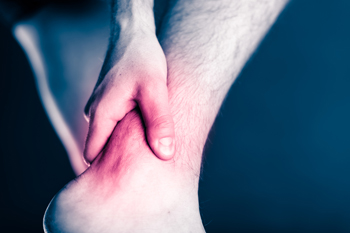
An Achilles tendon rupture is a significant injury that often occurs during sports or sudden movement, usually felt as a sharp pain or a popping sensation in the back of the ankle. Walking becomes difficult, and pushing off the foot may feel impossible. Management depends on the severity of the tear and the patient’s overall health and activity level. Non-surgical treatment includes immobilization with a cast or walking boot, followed by specific exercises to restore strength and flexibility. Surgical repair may be recommended for younger or more active individuals to reduce the risk of re-rupture and support a quicker return to activity. Both approaches require a period of rest, followed by a carefully guided rehabilitation program. Prompt diagnosis is key to determining the most effective treatment. If you experience sudden pain or loss of function in your lower leg, it is suggested you see a podiatrist for a diagnosis and appropriate treatment.
Achilles tendon injuries need immediate attention to avoid future complications. If you have any concerns, contact Richard DiBacco, DPM of Podiatry Associates of Erie, Inc.. Our doctor can provide the care you need to keep you pain-free and on your feet.
What Is the Achilles Tendon?
The Achilles tendon is a tendon that connects the lower leg muscles and calf to the heel of the foot. It is the strongest tendon in the human body and is essential for making movement possible. Because this tendon is such an integral part of the body, any injuries to it can create immense difficulties and should immediately be presented to a doctor.
What Are the Symptoms of an Achilles Tendon Injury?
There are various types of injuries that can affect the Achilles tendon. The two most common injuries are Achilles tendinitis and ruptures of the tendon.
Achilles Tendinitis Symptoms
- Inflammation
- Dull to severe pain
- Increased blood flow to the tendon
- Thickening of the tendon
Rupture Symptoms
- Extreme pain and swelling in the foot
- Total immobility
Treatment and Prevention
Achilles tendon injuries are diagnosed by a thorough physical evaluation, which can include an MRI. Treatment involves rest, physical therapy, and in some cases, surgery. However, various preventative measures can be taken to avoid these injuries, such as:
- Thorough stretching of the tendon before and after exercise
- Strengthening exercises like calf raises, squats, leg curls, leg extensions, leg raises, lunges, and leg presses
If you have any questions please feel free to contact one of our offices located in Erie and Meadville, PA, . We offer the newest diagnostic tools and technology to treat your foot and ankle needs.
Why Does The Bottom of My Foot Hurt?
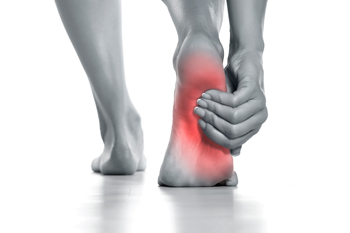
Pain in the bottom of the foot, especially sharp pain or a burning sensation, can be caused by several conditions. One common cause is plantar fasciitis, where the tissue along the bottom of the foot becomes inflamed, often leading to sharp pain near the heel. Another potential cause is neuropathy, a condition where nerve damage causes a burning or tingling sensation. Metatarsalgia or inflammation of the ball of the foot can also lead to discomfort, often described as a feeling of standing on a small stone. Symptoms typically include sharp or burning pain in the foot's arch or heel, especially after standing or walking for long periods. The area may feel tender, swollen, or tight. A podiatrist can help diagnose the underlying cause through physical exams, imaging tests, or nerve function tests. Treatment may include rest, stretching exercises, custom orthotics or anti-inflammatory medications. If you are dealing with foot pain, it is suggested that you make an appointment with a podiatrist for care.
Foot Pain
Foot pain can be extremely painful and debilitating. If you have a foot pain, consult with Richard DiBacco, DPM from Podiatry Associates of Erie, Inc.. Our doctor will assess your condition and provide you with quality foot and ankle treatment.
Causes
Foot pain is a very broad condition that could be caused by one or more ailments. The most common include:
- Bunions
- Hammertoes
- Plantar Fasciitis
- Bone Spurs
- Corns
- Tarsal Tunnel Syndrome
- Ingrown Toenails
- Arthritis (such as Gout, Rheumatoid, and Osteoarthritis)
- Flat Feet
- Injury (from stress fractures, broken toe, foot, ankle, Achilles tendon ruptures, and sprains)
- And more
Diagnosis
To figure out the cause of foot pain, podiatrists utilize several different methods. This can range from simple visual inspections and sensation tests to X-rays and MRI scans. Prior medical history, family medical history, and any recent physical traumatic events will all be taken into consideration for a proper diagnosis.
Treatment
Treatment depends upon the cause of the foot pain. Whether it is resting, staying off the foot, or having surgery; podiatrists have a number of treatment options available for foot pain.
If you have any questions, please feel free to contact one of our offices located in Erie and Meadville, PA, . We offer the newest diagnostic and treatment technologies for all your foot care needs.
Inspect Your Feet Regularly for Abnormalities if You're Diabetic
When Heel Pain Affects Your Life and Comfort
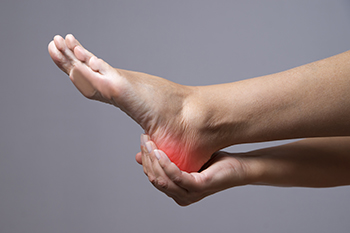
Plantar heel pain can make even simple movements feel difficult. It often starts as a sharp ache in the bottom of the heel, especially when taking the first steps in the morning or after resting. This kind of pain can limit walking, standing, and daily routines, affecting your ability to work, exercise, or enjoy time with others. Over time, the discomfort may lead to less activity, poor sleep, and changes in mood. Many people try to ignore the pain, but without treatment, it can linger or get worse. Wearing supportive shoes, stretching, resting and other treatments can help ease the symptoms. A podiatrist can guide you toward the most effective options to improve your comfort and keep you moving. If you have plantar heel pain, it is suggested that you see a podiatrist for relief options.
Many people suffer from bouts of heel pain. For more information, contact Richard DiBacco, DPM of Podiatry Associates of Erie, Inc.. Our doctor can provide the care you need to keep you pain-free and on your feet.
Causes of Heel Pain
Heel pain is often associated with plantar fasciitis. The plantar fascia is a band of tissues that extends along the bottom of the foot. A rip or tear in this ligament can cause inflammation of the tissue.
Achilles tendonitis is another cause of heel pain. Inflammation of the Achilles tendon will cause pain from fractures and muscle tearing. Lack of flexibility is also another symptom.
Heel spurs are another cause of pain. When the tissues of the plantar fascia undergo a great deal of stress, it can lead to ligament separation from the heel bone, causing heel spurs.
Why Might Heel Pain Occur?
- Wearing ill-fitting shoes
- Wearing non-supportive shoes
- Weight change
- Excessive running
Treatments
Heel pain should be treated as soon as possible for immediate results. Keeping your feet in a stress-free environment will help. If you suffer from Achilles tendonitis or plantar fasciitis, applying ice will reduce the swelling. Stretching before an exercise like running will help the muscles. Using all these tips will help make heel pain a condition of the past.
If you have any questions, please feel free to contact one of our offices located in Erie and Meadville, PA, . We offer the newest diagnostic and treatment technologies for all your foot care needs.
Easing the Pain of Plantar Fasciitis
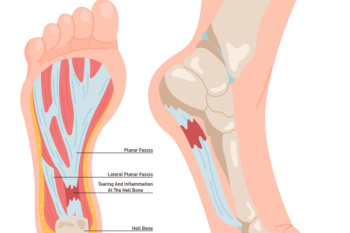
Plantar fasciitis is a well-known cause of heel pain, often felt as a sharp, stabbing sensation with the first steps in the morning or after periods of rest. The condition results from inflammation of the plantar fascia, a thick band of tissue that connects the heel to the toes. While it can be persistent, several strategies may help reduce discomfort and promote healing. Stretching exercises for the calf muscles and plantar fascia can improve flexibility and reduce strain. Wearing supportive shoes with good arch support and cushioned soles is essential for daily comfort. Custom orthotics can also help distribute pressure more evenly across the foot. Using anti-inflammatory medications may ease pain in the short term. However, if you are experiencing ongoing heel pain, it is suggested that you see a podiatrist for a proper diagnosis and appropriate treatment.
Plantar fasciitis can be very painful and inconvenient. If you are experiencing heel pain or symptoms of plantar fasciitis, contact Richard DiBacco, DPM from Podiatry Associates of Erie, Inc.. Our doctor can provide the care you need to keep you pain-free and on your feet.
What Is Plantar Fasciitis?
Plantar fasciitis is the inflammation of the thick band of tissue that runs along the bottom of your foot, known as the plantar fascia, and causes mild to severe heel pain.
What Causes Plantar Fasciitis?
- Excessive running
- Non-supportive shoes
- Overpronation
- Repeated stretching and tearing of the plantar fascia
How Can It Be Treated?
- Conservative measures – anti-inflammatories, ice packs, stretching exercises, physical therapy, orthotic devices
- Shockwave therapy – sound waves are sent to the affected area to facilitate healing and are usually used for chronic cases of plantar fasciitis
- Surgery – usually only used as a last resort when all else fails. The plantar fascia can be surgically detached from the heel
While very treatable, plantar fasciitis is definitely not something that should be ignored. Especially in severe cases, speaking to your doctor right away is highly recommended to avoid complications and severe heel pain. Your podiatrist can work with you to provide the appropriate treatment options tailored to your condition.
If you have any questions, please feel free to contact one of our offices located in Erie and Meadville, PA, . We offer the newest diagnostic and treatment technologies for all your foot care needs.
Say Goodbye to Ingrown Toenail Pain
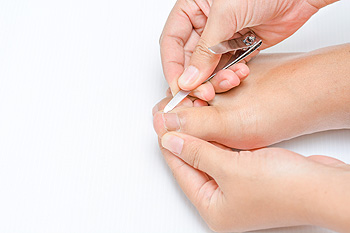
An ingrown toenail might seem like a small problem, but it can cause big discomfort. When the edge of the nail grows into the surrounding skin, it can lead to redness, swelling, pain, and even infection. Wearing tight shoes, improper nail trimming, and injuries often make the problem worse. While home remedies may provide temporary relief, persistent or painful ingrown toenails need professional care. A podiatrist can safely remove the problem portion of the nail, easing your pain and helping to prevent future issues. In some cases, they may recommend a simple procedure to stop the nail from growing back improperly. If you have an ingrown toenail that will not heal or keeps coming back, it is suggested that you schedule an appointment with a podiatrist who can provide the expert care you need.
Ingrown toenails may initially present themselves as a minor discomfort, but they may progress into an infection in the skin without proper treatment. For more information about ingrown toenails, contact Richard DiBacco, DPM of Podiatry Associates of Erie, Inc.. Our doctor can provide the care you need to keep you pain-free and on your feet.
Ingrown Toenails
Ingrown toenails are caused when the corner or side of a toenail grows into the soft flesh surrounding it. They often result in redness, swelling, pain, and in some cases, infection. This condition typically affects the big toe and may recur if it is not treated properly.
Causes
- Improper toenail trimming
- Genetics
- Improper shoe fitting
- Injury from pedicures or nail picking
- Abnormal gait
- Poor hygiene
You are more likely to develop an ingrown toenail if you are obese, have diabetes, arthritis, or have any fungal infection in your nails. Additionally, people who have foot or toe deformities are at a higher risk of developing an ingrown toenail.
Symptoms
Some symptoms of ingrown toenails are redness, swelling, and pain. In rare cases, there may be a yellowish drainage coming from the nail.
Treatment
Ignoring an ingrown toenail can have serious complications. Infections of the nail border can progress to a deeper soft-tissue infection, which can then turn into a bone infection. You should always speak with your podiatrist if you suspect you have an ingrown toenail, especially if you have diabetes or poor circulation.
If you have any questions, please feel free to contact one of our offices located in Erie and Meadville, PA, . We offer the newest diagnostic and treatment technologies for all your foot care needs.




